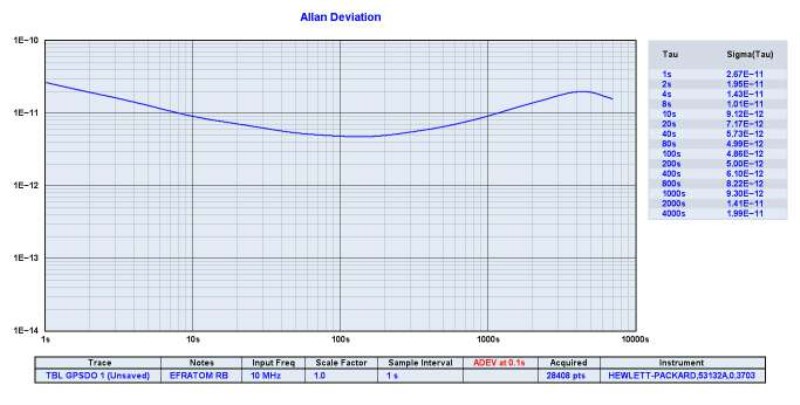Type:Logic ICs
Condition:New
Model Number:GPSDO
Decoration and Construction Contents:GPSDO
Color classification:Square wave sine wave

GPSDO, GPS clock, GPS clock, 10M output, better than atomic clock
The main feature of the tame clock is fast locking speed, open ground, within 3-5 minutes, the frequency accuracy can reach 5E-9.0.05Hz10MHz
The final accuracy will be 2E-11 (0.0002Hz10MHz)
Name: GPS tame clock
NAME: GPS DISCIPLINED CLOCK
Power supply: DC11.7-12.9V,<=15W
POWER:DC11.7-12.9V,<=15W
GPS Antenna Power Supply: DC3.3V
GPS ANT POWER: DC3.3V
1PPS output waveform, amplitude: square wave, 3.3Vpp
1PPS OUTPUT: SQUARE WAVE, 3.3Vpp
10M output waveform amplitude: sine wave, 1Vrms, (13dBm +3dB)
10M OUTPUT: SINE WAVE, 1Vrms (13dBm+-3dB)
RS232 Output: GPS NMEA Signal
RS232 OUTPUT: GPS NMEA SIGNAL
Accuracy: 2 orders of magnitude higher than the constant temperature crystal oscillator
ACCURACY: above than OCXO 2Order of magnitude
Shape size: W * H * D = 107 * 55 * 122 mm (including front connector)
SIZE: W*H*D=107*55*122 mm (INCLUDE BNC CONNECT)
Accessories: AC110-220-DC12V transformer, 5m GPS antenna.
ACCESSORY: AC110-220-DC12V ADAPTER, 5 m GPS ANT.
1. What is GPS and what is GPSDO? GPS is abbreviated as Global Positioning System in English and Global Positioning System in Chinese. Our daily use is its positioning function. Another important use of GPS is timing. GPSDO is the abbreviation of Global Positioning System disciplined oscillator in English. The Chinese full name is GPS tame clock. Even use GPS timing function to adjust the clock to make the clock more accurate. 2. What is the basic principle of GPS tame clock? Why is it more accurate than atomic clock? The basic principle of GPS taming clock is that the standard time signal output by GPS module is usually a second pulse (1pps). To control or compare the frequency of constant temperature crystal oscillator, and then output signal to correct the frequency error of constant temperature crystal oscillator. Because there is no accumulated error in the output of GPS signal and the long-term accuracy is very high, the tamed constant temperature crystal oscillation accuracy is more accurate than the atomic clock. 3. Where are GPS tame clocks used more? Most of them are the base stations of mobile phones, which are used as standard signal sources for reference. 4. Can I use it without GPS antenna? GPS antenna can be disconnected, at this time GPSDO is equal to a common constant temperature crystal oscillator. 5. How to place the GPS antenna, indoor or near the window with glass? What if the GPS can't lock? It needs to be placed outdoors, directly facing the sky, not across the glass, because the glass attenuates 1.5G signal and is very large. Antenna can be directed to the sky, at least one fifth of the sky area, otherwise the sky area is small, GPS signal is poor, and frequency accuracy is poor. GPS can not be locked, mainly facing the sky is relatively small, choose an antenna in the open place, can also be placed on the back of the antenna iron plate, appropriate adjustment of the distance between the iron plate and the antenna, enhance the signal. 6. What if the antenna is not long enough due to the restrictions? Extension line can be added. The author's test environment uses 8 meters long extension line. Long GPS antennas can also be purchased, such as ship GPS antennas, some up to 30 meters, 50 meters, and even up to 100 meters. 7. Can a GPS antenna receive a cable TV antenna at home? No, cable TV doesn't have a 1.575G GPS signal. 8. How to use the circuit board when you get it? Connected with GPS antenna, antenna to sky, connected with DC12V/1.5A power supply, the corresponding SMA port can output 10MHz standard signal. 9. Is there any application in the field of HIFI? Is it too abstruse to use in audio? Very few, you can say no. Used in acoustics is not at all mysterious, accurate frequency, sound details enhanced, analytical power increased, background murmur reduced. 10. My DAC uses 16.9344M frequency, and you output 10M signal if you use it.
The 10M signal is converted into 16.9344M signal by a converter.

